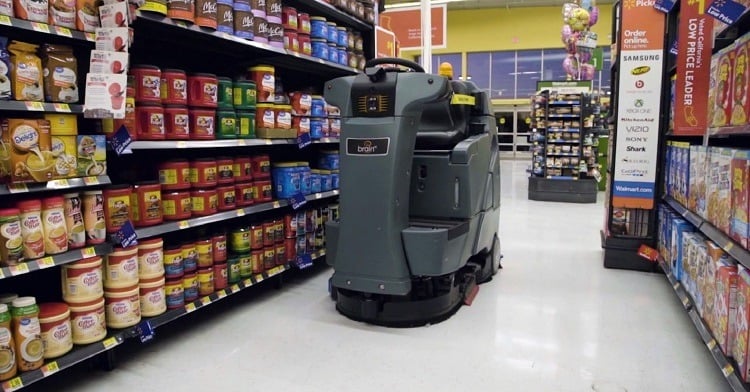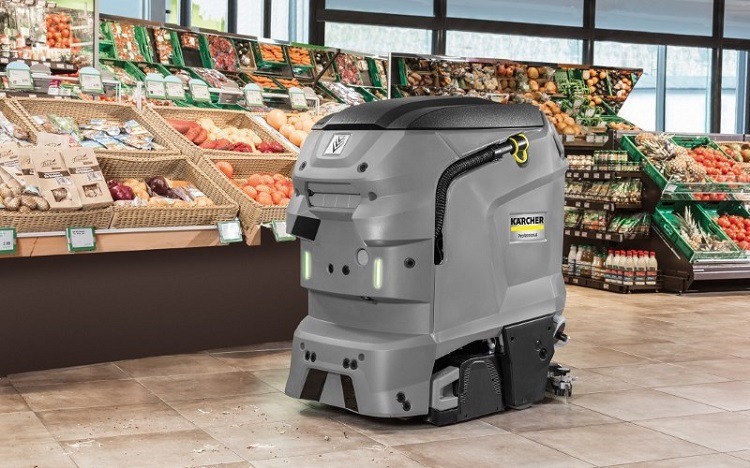6 Robot Janitors Doing Commercial Floor Cleaning
Table of contents
Table of contents

It’s the boring stocks that let you sleep well at night, and that’s because there is a lot of money being made in boring industries. Take the cleaning industry for example. It’s an often-overlooked field, but surprisingly one of the most profitable and sustainable. Nobody wants to work in an unclean office environment, and there are rules and regulations that compel employers to make sure everything is up to snuff. This means loads of cleaning needs to be done every night. According to the Bureau of Labor Statistics, there are 2,384,600 building janitors and cleaners representing an annual spend of nearly $60 billion. As for future jobs in the cleaning space, “the employment of janitors and building cleaners is projected to grow 10 percent from 2016 to 2026, faster than the average for all occupations.”
Inasmuch as it’s brimming with potential, the cleaning industry also has the pickiest customers. In fact, an average contractor in the janitorial business can lose up to 55% of his clients at any given time if their services fail to meet expectations. Plus, competition can be fierce with over 917,000 janitorial businesses in the United States all trying to compete for the same customers. Moreover, insurance can be expensive since the janitorial industry records one of the highest numbers of occupational injuries according to the Bureau of Labor.
Source: Bureau of Labor
So, let’s just review here:
- Tough job that requires physical labor that’s above most people in ‘Murica – YES
- High standards of work that entitled people (cough, America’s youth, cough) won’t be able to meet – YES
- Job with high number of occupational injuries – YES
- Job that requires odd working hours – YES
- Fragmented industry ripe for technological disruption – YES
- Total Addressable Market exceeding $50 billion – YES
Sounds like the perfect solution for some robots. While this is not an exhaustive list by any means, what we’re going to look at next are 6 examples of startups and companies that are in the robot janitor market and cleaning commercial floors today.
6 Robot Janitors Doing Commercial Floor Cleaning


Expect the floor scrubbing robot to have routing algorithms, 4G LTE connectivity, sensors, and cameras. If you recall from our previous article on Brain Corp, one of their investors is Softbank, a company that’s also been developing their own janitor robot which vacuums floors.
Update 04/24/2020: Brain Corp has raised $36 million in Series D funding for further expansion into retail, healthcare, airports, and schools. This brings the company’s total funding to $161 million to date.
We’re probably all familiar with Tokyo conglomerate SoftBank, a company that’s been throwing $100 million at pretty much anything that moves. They’ve also been developing Whiz, a robot janitor designed specifically to vacuum clean commercial establishments, in collaboration with Brain Corp of course. With Japan’s chronic labor shortage, SoftBank expects Whiz to be the perfect solution for the problem especially since the Japanese still have “unresolved feelings” about hiring immigrant workers. After Pepper, a talking humanoid robot they launched in 2014, this robot looks a little less human:

According to the Nikkei Review, the Whiz can vacuum 1,500 sq. meters in three hours, moving along a route that a human needs to “teach” it just once. At the same time, it’s also been trained to dodge unexpected obstacles, like bowing Japanese people. Softbank plans to have the robot janitor rented for around 25,000 yen ($222 USD) per month starting in early 2019 with overseas markets targeted by the end of 2019.
Kärcher is a German family-owned company that operates worldwide with 10,000 employees as a world market leader in cleaning technology. They’ve managed to develop their own robotic janitor platform called Karcher Intelligent Robotic Applications or KIRA. According to Kärcher, KIRA was built in an “extremely flexible and demand-oriented manner,” with a multisensory system that ensures the safety of the people and the properties around it. The robot you see below is the KIRA B 50, a professional automatic scrubber drier that marks the start of a complete range of autonomous cleaning machines the company is planning for.

The robot comes equipped with GPS tracking and mobile data transmission to provide analysis data as well as send text notifications to its users. When it’s done cleaning or completing janitor-type stuff, KIRA will automatically go back to its docking station where it will clean its tank, drain the dirty water, recharge its batteries, and refill with fresh water.
Founded in 2014, Canadian startup Avidbots has taken in $3 million in funding so far to develop Neo, a purpose-built floor cleaning robot that uses 3D cameras, AI navigation, sensors, and lasers to clean floors around the world.
Update 03/22/2019: Avidbots has raised $23.6 million in Series B funding to accelerate investment in talent acquisition, engineering, marketing, and sales to bring their cutting-edge robots to more customers worldwide. This brings total funding to $26.6 million to date.
Safety is also one of the primary concerns of this robot as it comes with features like collision avoidance technology, a low 72 dBA noise rating, an e-stop button, protective bumpers and flaps, and warning lights.

The company has rapidly expanded with a global service network covering North & South America, Europe, Middle East, and Asia Pacific. If you’re passing through airports around the world, you may see it being used in places like Singapore’s Changi Airport or France’s Paris Charles De Gaulle Airport. They’re already on their 8th generation of product design which all takes place at their Canadian headquarters, a 40,000 sq. ft industrial manufacturing and R&D facility, where more than 80 employees are developing today’s robot janitors.
Founded in 2015, Vancouver startup A&K Robotics has taken in an undisclosed amount in funding to develop an automation module that converts manual cleaning machines into self-driving robots. Founded by engineering students from the University of British Columbia (UBC), this startup had its pilot in the school which led to some real janitorial contracts with the Vancouver International Airport. The solution is particularly attractive because it consists of an automation module that is attached to the top of your bog-standard automatic floor cleaner.

Once it’s activated, the machine will transform into a robotic floor scrubber. When it’s done cleaning, the robot will send a text to the custodian on duty who will then be in charge of tasks like recharging the machine and replenishing its tank. Sounds like this company might make a good aqui-hire for Avidbots.


These Hands-Free Cleaning machines can work in the dark, reducing carbon emissions, and saving money on air conditioning and lights. It’s also an eco-friendly cleaning solution which uses an average of 85% less cleaning solution per shift, something that it reports every day to a central server providing loads of big data that can be munched on later.
Conclusion
Considering that labor accounts for 80% of the costs of commercial floor cleaning, you can imagine how much robot janitors like these are making low-margin businesses salivate. And the size of the total addressable market assures that plenty of entrants can play in this space. Just this month, CNBC published an article on how “Walmart will soon use hundreds of A.I. robot janitors to scrub the floors of US stores.” The article goes on to say that “Walmart will deploy 360 floor-scrubbing robots armed with computer vision and AI capabilities in hundreds of its stores by the end of January 2019,” these robots, of course, will be powered by the aforementioned Brain Corp. It’s not just that 360 janitors could be “looking for more value-added tasks,” but additional jobs may be impacted as well. A paper by the National Bureau of Economic Research states that between 1990 and 2007, the addition of one robot lowered employment in the United States by 5.6 workers.
Of course, janitor work is above most young Americans anyways, so we’re really just addressing a future labor shortage problem given the growth this industry expects. Those people who did have career aspirations to be “floor technicians” can now move on to more value-added activities. Walmart, a company that has increased their dividends for 45 years straight, now has improved margins for further dividend increases that we’ve become so accustomed to. Everyone wins here people.
Sign up to our newsletter to get more of our great research delivered straight to your inbox!
Nanalyze Weekly includes useful insights written by our team of underpaid MBAs, research on new disruptive technology stocks flying under the radar, and summaries of our recent research. Always 100% free.















What is the cost for your machines? I am looking at investing for my school district but can they work in a tight space with desks and what type of cleaning would I expect?
Do they have the ability tp empty garbage cans?
Thank you for your inquiry Tom.
Our MBAs aren’t for sale, but we would consider leasing them out at the right price. We can assure you they can definitely work in tight spaces, however, because they have MBAs, you may need to show them how to use a broom. They can empty garbage cans thought we reserve the right to all aluminum cans found during the process.
Oh! You were talking about the robots! Sorry about that. You’d have to contact the robot janitor companies directly.
I use a robotic scrubber and it does a terrible job. You have to baby sit it constantly and the jobs there say that the robot makes easier is bull. It makes my job ten times harder. It is not worth it, you get more done with a manual riding machine. And a lot easier job on top of that.
Maybe in version 1.0, but not after it learns how to manage your complaints.
I’ve seen TOOOOO many of these that just say “we have this product”, yet, doesn’t sell it. Waste of time.
That’s why revenues are so critically important to prove traction.